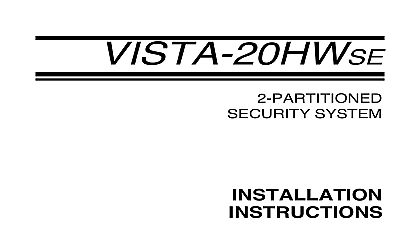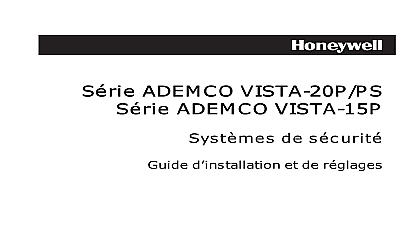Ademco - Vista 20SE Installation Manual

File Preview
Click below to download for free
Click below to download for free
File Data
| Name | ademco-vista-20se-installation-manual-4650397281.pdf |
|---|---|
| Type | |
| Size | 1.54 MB |
| Downloads |
Text Preview
VISTA 20SE SYSTEM changes between the VISTA 20SE and the VISTA 20 are indicated by margin lines 8 97 FOR PROPER PROTECTION Following Recommendations For The Location Of Fire And Burglary Detection Devices Help Proper Coverage For The Protected Premises For Smoke And Heat Detectors regard to the number and placement of smoke heat detectors we subscribe to the recommendations in the National Fire Protection Association NFPA Standard 72 noted below warning fire detection is best achieved by the installation of fire detection equipment in all and areas of the household as follows For minimum protection a smoke detector should be outside of each separate sleeping area and on each additional floor of a multi floor living unit including basements The installation of smoke detectors in kitchens attics or unfinished or in garages is not normally recommended additional protection the NFPA recommends that you install heat or smoke detectors in the room dining room bedroom s kitchen hallway s attic furnace room utility and storage basements and attached garages addition we recommend the following a smoke detector inside every bedroom where a smoker sleeps a smoke detector inside every bedroom where someone sleeps with the door partly or closed Smoke could be blocked by the closed door Also an alarm in the hallway may not wake up the sleeper if the door is closed a smoke detector inside bedrooms where electrical appliances such as portable heaters air or humidifiers are used a smoke detector at both ends of a hallway if the hallway is more than 40 feet 12 meters smoke detectors in any room where an alarm control is located or in any room where alarm connections to an AC source or phone lines are made If detectors are not so located a fire the room could prevent the control from reporting a fire or an intrusion CONTROL COMPLIES WITH NFPA REQUIREMENTS FOR TEMPORAL PULSE OF FIRE NOTIFICATION APPLIANCES ROOM ROOM ROOM Detectors for Minimum Protection Detectors for Additional Protection Detectors RM CLOSED For Proper Intrusion Protection proper intrusion coverage sensors should be located at every possible point of entry to a home or premises This would include any skylights that may be present and the upper windows in a building addition we recommend that radio backup be used in a security system so that alarm signals can still sent to the alarm monitoring station in the event that the telephone lines are out of order alarm signals normally sent over the phone lines if connected to an alarm monitoring station 1 2 3 4 TABLE OF CONTENTS DESCRIPTION THE CONTROL the Cabinet the Lock if used the Control Circuit Board Alone in the Cabinet Control and RF Receiver Circuit Boards Together in the Cabinet Phone Line Connections the AC Transformer the Back Up Battery Ground Connections REMOTE KEYPADS That May Be Used The Keypads The Keypads A Supplementary Power Supply To Power Additional Keypads Check Out Procedure HARD WIRED ZONES 1 the Hard Wired Zones Characteristics For Zones 1 Burglary and Panic Devices to Zones 1 2 Wire Smoke Detectors to Zone 1 Operation of 2 Wire Smoke Detectors in Zone 1 Off Fire Alarm Sounding 4 Wire Smoke Combustion Detectors on Zones 2 2 Wire Latching Type Glass Break Detectors on Zone 8 Procedure for Hard Wired Zones 5 WIRED ZONE EXPANSION 4219 4229 Zone Expansion Units and Set Up Procedure for Wired Expansion Zones 6 WIRELESS ZONE EXPANSION 5800 SYSTEM Information Supervision Identification the 5881 5882 RF Receiver System Installation Advisories and Set Up of the 5881 5882 Receiver the 5800TM Module the 5800TM Module Wiring Connections Series Transmitters Supervision Input Types Battery Life the Transmitter Sniffer Mode Series Transmitters Table 7 OUTPUTS POWERLINE CARRIER DEVICES Carrier Device Basics 4204 And 4229 Output Relay Modules


